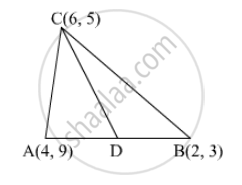Advertisements
Advertisements
प्रश्न
If A(4, 9), B(2, 3) and C(6, 5) are the vertices of ∆ABC, then the length of median through C is
पर्याय
5 units
- \[\sqrt{10}\] units
25 units
10 units
उत्तर
It is given that A(4, 9), B(2, 3) and C(6, 5) are the vertices of ∆ABC.

Let CD be the median of ∆ABC through C. Then, D is the mid-point of AB.
Using mid-point formula, we get
Coordinates of D = \[\left( \frac{4 + 2}{2}, \frac{9 + 3}{2} \right) = \left( \frac{6}{2}, \frac{12}{2} \right) = \left( 3, 6 \right)\]
∴ Length of the median, AD
\[= \sqrt{\left( 6 - 3 \right)^2 + \left( 5 - 6 \right)^2} \left( \text{ Using distance formula } \right)\]
\[ = \sqrt{3^2 + \left( - 1 \right)^2}\]
\[ = \sqrt{10} \text{ units } \]
Thus, the length of the required median is \[\sqrt{10}\] units.
APPEARS IN
संबंधित प्रश्न
On which axis do the following points lie?
Q(0, -2)
Which point on the x-axis is equidistant from (5, 9) and (−4, 6)?
Find the equation of the perpendicular bisector of the line segment joining points (7, 1) and (3,5).
Prove that the points (3, 0), (4, 5), (-1, 4) and (-2, -1), taken in order, form a rhombus.
Also, find its area.
Find a point on y-axis which is equidistant from the points (5, -2) and (-3, 2).
Find the ratio in which the line segment joining (-2, -3) and (5, 6) is divided by x-axis Also, find the coordinates of the point of division in each case.
The line segment joining the points P(3, 3) and Q(6, -6) is trisected at the points A and B such that Ais nearer to P. If A also lies on the line given by 2x + y + k = 0, find the value of k.
Find the centroid of ΔABC whose vertices are A(2,2) , B (-4,-4) and C (5,-8).
Point P(x, 4) lies on the line segment joining the points A(−5, 8) and B(4, −10). Find the ratio in which point P divides the line segment AB. Also find the value of x.
Prove hat the points A (2, 3) B(−2,2) C(−1,−2), and D(3, −1) are the vertices of a square ABCD.
Find the value of k, if the points A (8, 1) B(3, −4) and C(2, k) are collinear.
\[A\left( 6, 1 \right) , B(8, 2) \text{ and } C(9, 4)\] are three vertices of a parallelogram ABCD . If E is the mid-point of DC , find the area of \[∆\] ADE.
What is the distance between the points (5 sin 60°, 0) and (0, 5 sin 30°)?
Write the coordinates of a point on X-axis which is equidistant from the points (−3, 4) and (2, 5).
If the area of the triangle formed by the points (x, 2x), (−2, 6) and (3, 1) is 5 square units , then x =
If point P is midpoint of segment joining point A(– 4, 2) and point B(6, 2), then the coordinates of P are ______
What are the coordinates of origin?
The line segment joining the points (3, -1) and (-6, 5) is trisected. The coordinates of point of trisection are ______.
The line 3x + y – 9 = 0 divides the line joining the points (1, 3) and (2, 7) internally in the ratio ______.
Point (3, 0) lies in the first quadrant.
